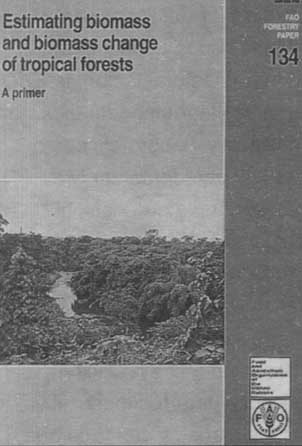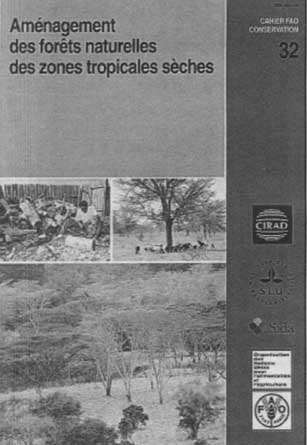A practical guide to estimating forest biomass
Controlling wind erosion in the Niger
Termites in dryland management
International conference on non-timber forest products in agroforestry
Recent efforts aimed at developing forest harvesting codes
Managing natural forests in the dry tropics
Estimating biomass and biomass change of tropical forests: a primer By S. Brown 1897. FAO Forestry Paper No. 134. Rome, FAO.
Climate change is one of the truly global issues of our time, and forests play an important role in it. Changes in the cover, use and management of forests produce sources and sinks of carbon dioxide which are exchanged with the biosphere. Estimation of the magnitude of these sources and sinks requires reliable estimates of the biomass density of forests.

This is the background to this "primer" for estimating biomass and biomass change of tropical forests. It focuses on tropical forests whose high potential biomass gives any changes taking place in them a particular significance and it is concerned with one important component of the total biomass, namely aboveground wood biomass in trees with a diameter of at least 10 cm at breast height.
Describing the state and change with regard to biomass requires observations of the state and change of area and of biomass per unit of area (biomass density in the terminology of this report). As reliable observations of biomass per unit area are generally scarce, this primer endeavours to:
· outline methods that are available for estimating biomass per hectare of tropical forests using mainly existing data; and
· describe primary data and measurement requirements for assessment of forest inventories and in training in forest inventory.
In addition, it presents biomass estimates for many tropical countries using the methodologies given. As such, it should be of value to planners of forest inventories and in training for forest inventory.
Wind erosion in the Sahelian zone Or Niger processes, models and control techniques. By G. Sterk. Tropical Resource Management Papers No 15. Wageningen, the Netherlands, Wageningen Agricultural University.
In the Sahelian zone of the Niger, severe wind erosion occurs mainly in the first half of the rainy season (May-July), when violent winds preceding thunderstomms result in intense sediment transport.
Quantification of this wind erosion is difficult owing to a high degree of temporal and spatial variability in wind-blown particle mass fluxes. Using improved techniques to collect field data in the Niger and developed models revealed that a single wind erosion event may result in severe losses of soil particles and nutrients from unprotected fields. The many technical measures available to reduce wind erosion do not always fit into the Sahelian farming systems. A survey revealed that mulching with crop residues is the main control technique applied by farmers of the Niger, but the quantity of crop residues available for soil conservation is limited, as stover also has other important uses. Field tests with flat pearl millet stalks showed that small quantities can significantly reduce sediment transport during moderate storms. However, sediment transport may actually be intensified by small quantities of mulch during severe storms, because of increased turbulence around the stalks.
The role of termites and mulch In the rehabilitation of crusted Sahelian soils By A. Mando. Tropical Resource Management Papers No 16. Wageningen, the Netherlands, Wageningen Agricultural University.
During the last few decades, Sahelian soils have gone through various forms of degradation, the most spectacular one being the extension of base and crusted soils. Mulch, when placed on a crusted and bare soil, triggers termite activity within a few months. Many burrows are opened through the sealed surface of the soil by the burrowing activity of the termites. Throughout the soil profile, macropores with irregular shapes and with different diameter sizes are created.
As a result of changes in soil structure, other soil physical properties are also improved. Soil resistance to cone penetration is reduced from a critical to a suitable level for vegetation growth. Bulk density is decreased and soil hydraulic conductivity is considerably increased. Water infiltration and drainage are also greatly improved. The combination of the increase of porosity and infiltration and the cover effect of mulch results in an increase of soil water availability in the soil profile during the growing season.
Termite activity enhances decomposition of the mulch and hence nutrient release in the soil. The change of soil characteristics caused by termite activity was enough to create conditions necessary for natural vegetation development and crop production on previously degraded bare soils in the Sahelo-Sudan zone of northern Burkina Faso.
Domestication and commercialization of non-timber forest products in agroforestry systems. Non-Word Forest Products Paper No. 9.1996. Rome, FAO.
This volume contains the proceedings of the International Conference on Domestication and Commercialization of Non-Timber Forest Products in Agroforestry Systems, held in Nairobi, Kenya from 19 to 23 February 1996.
ii
The conference, hosted by the International Centre for Research in Agroforestry (ICRAF). was the first world-level meeting to be held exclusively to draw attention to issues dealing with domestication and commercialization of non-timber forest products in agroforestry systems.
The report is organized according to the five thematic areas considered by the conference: assessment and monitoring of non-timber forest products; indigenous knowledge and ethnobotany; product development and management; product domestication and adoption by farmers; and policy and institutional aspects. Under these five areas, 26 background papers were discussed - they form the bulk of these proceedings, followed by reports of each of the five thematic working groups.
Overall, the perspectives on domestication and commercialization of non-timber forest products in agroforestry systems, as they emerged from the conference discussions, and the light that they throw on how to address issues dealing with resource assessment, indigenous knowledge, product development, socio-economic benefits, environmental impact and institutional and policy aspects, will be of value to national and international agencies in designing and implementing their future activities on non-timber forest products.
Forest codes of practice: Contributing to environmentalty sound forest operations. FAO Forestry Paper No. 133 1996 D. Dykstra and R. Heinrich, eds. Rome, FAO.

This report presents a collection of papers on recent efforts to develop guidelines and codes of practice in forest operations and engineering. The papers were presented at the Meeting of Experts on Forest Practices, which was held from 11 to 14 December 1994 at the Food and Agriculture Development Centre of the German Foundation for International Development, Feldafing, Germany. The meeting was convened jointly by the Forest Harvesting and Transport Branch of FAO and the Subject Group S3.05, Forest Operations in the Tropics, a research group of the International Union of Forestry Research Organizations (IUFRO).
The objectives of the meeting were twofold:
· to provide information and exchange experience on recently developed guidelines and codes in forest harvesting; and
· to review the FAO Model Code of Forest Harvesting Practice.
In response to the United Nations Conference on Environment and Development (UNCED), held in Rio de Janeiro in 1992, and in particular with reference to Agenda 21, Chapter 11, dealing with Combating Deforestation, FAO organized the above-mentioned expert meeting and developed the FAO Model Code:
· to enhance the protection, sustainable management and conservation of all forests and rehabilitation of degraded areas; and
· to promote efficient utilization and assessment to recover the full value of goods and services provided by forests and woodlands.
The information provided in this report and the Model Code are intended primarily to serve as reference material, to promote harvesting practices that will improve standards of utilization, reduce environmental impacts and ensure that forests are sustained for future generations, as well as to improve the economic and social contributions of forestry as a component of sustainable development.
Aménagement des forêts naturelles des zones tropicales sèches By R. Bellefontaine, A. Gaston and Y. Petrucci. 1997. FAO Conservation Guide No. 32. Rome, FAO.

One of the notable results of the United Nations Conference on Environment and Development (UNCED) in terms of forestry was the heightened worldwide attention focused on sustainable management of natural forests. Notwithstanding the fact that the bulk of world attention has been focused on moist tropical formations, those in the dry zones have also been recognized as of extreme importance.
These forest formations, for the people of the countries in which they are found (primarily in Africa but also in Asia and Latin America), are essential in the satisfaction of energy requirements, provision of woody material, the production of fodder and browse for animals and, not least, their multiple functions in terms of maintenance of a fragile ecological balance.
Against this background, a joint initiative has been taken by FAO and the Swedish International Development Agency (SIDA) to examine the state of management of dry topical forests and to promote the identification, further development and implementation of promising practices.
The first part of the document reviews the nature and diversity of the dry forest formations as well as the biological, socio-economical and human factors that have led to their present state. Subsequently, the document considers the concept of management of dry tropical forest from both a theoretical and a practical point of view. Of particular note are the collection of case studies presenting practical experiences with promising methodologies.
This document will be of value to specialists in the fields of forest management, and particularly those focusing on the sustainable management of silvopastoral environments. It should also provoke further contributions to the debate and help to stimulate additional research in this area.